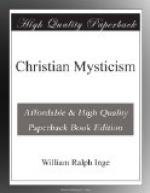“Die Lieb’ ist
freigegeben
Und keine Trennung
mehr
Es wogt das volle Leben
Wie ein unendlich
Meer.
Nur eine Nacht der Wonne,
Ein ewiges Gedicht!
Und unser Aller Sonne
Ist Gottes Angesicht.”
NOVALIS.
NATURE-MYSTICISM—continued
“The invisible things of Him since the creation of the world are clearly seen, being understood through the things that are made, even His everlasting power and Divinity.”—ROM. i. 20.
In my last Lecture I showed how the later Mysticism emancipated itself from the mischievous doctrine that the spiritual eye can only see when the eye of sense is closed. After the Reformation period the mystic tries to look with both eyes; his aim is to see God in all things, as well as all things in God. He returns with better resources to the task of the primitive religions, and tries to find spiritual law in the natural world. It is true that a strange crop of superstitions, the seeds of which had been sown long before, sprang up to mock his hopes. In necromancy, astrology, alchemy, palmistry, table-turning, and other delusions, we have what some count the essence, and others the reproach, of Mysticism. But these are, strictly speaking, scientific and not religious errors. From the standpoint of religion and philosophy, the important change is that, in the belief of these later mystics, the natural and the spiritual are, somehow or other, to be reconciled; the external world is no longer regarded as a place of exile from God, or as a delusive appearance; it is the living vesture of the Deity; and its “discordant harmony,[364]” though “for the many it needs interpreters,[365]” yet “has a voice for the wise” which speaks of things behind the veil. The glory of God is no longer figured as a blinding white light in which all colours are combined and lost; but is seen as a “many-coloured wisdom[366]” which shines everywhere, its varied hues appearing not only in the sanctuary of the lonely soul, but in all the wonders that science can discover, and all the beauties that art can interpret. Dualism, with the harsh asceticism which belongs to it, has given way to a brighter and more hopeful philosophy; men’s outlook upon the world is more intelligent, more trustful, and more genial; only for those who perversely seek to impose the ethics of selfish individualism upon a world which obeys no such law, science has in reserve a blacker pessimism than ever brooded over the ascetic of the cloister.
We shall not meet, in this chapter, any finer examples of the Christian mystic than John Smith and William Law. But these men, and their intellectual kinsmen, were far from exhausting the treasure of Nature-Mysticism. The Cambridge Platonists, indeed, somewhat undervalued the religious lessons of Nature. They were scholars and divines, and what lay nearest their heart was the consecration of the reason—that is, of the whole personality under the guidance of its highest faculty—to the service of truth and goodness. And Law, in his later years, was too much under the influence of Boehme’s fantastic theosophy to bring to Nature that childlike spirit which can best learn her lessons.




